LE MARCHÉ BASTILLE-RICHARD LENOIR—A GUARANTEED CULINARY ADVENTURE
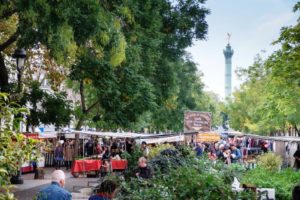
There are dozens of outdoor markets in Paris, at least two in each of the city’s 20 arrondissements. Probably the largest, and many argue the best, is the fantastic Marché Richard-Lenoir—more commonly called the Marche Bastille, held Thursdays and Sundays along the grand Boulevard Richard Lenoir, just north of the Place de la Bastille. The focus is the wonderful range of foods grown by local area farmers, quite a few of which are certified organic growers. As though that were not enough of an attraction, there are beautiful flower stalls, and vendors with a wide range of merchandise, ranging from small kitchen gadgets to African artefacts and fashion. Most of the crowd will be eager local shoppers with shopping trolleys and dogs in tow, rather than hordes of tourists.
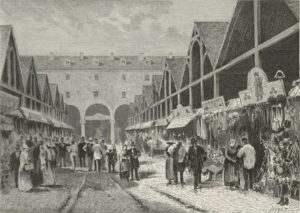
Boulevard Richard-Lenoir, running from the Bastille to the Avenue de la République, is one of the numerous wide tree-lined boulevards that were part of the vast public works carried out in Paris by Baron Haussmann during the Second Empire of Napoleon III. Many neighbourhoods, little changed since the Middle Ages, were demolished, deemed by officials as overcrowded, unhealthy, and often dangerous. Traffic circulation was another major problem so that wagons, carriages and carts could barely move through the streets. Despite much fierce opposition, locals were forced out of their homes, buildings torn down and these neighbourhoods were replaced by wide avenues, new parks and squares, the construction of new sewers, fountains, and aqueducts as well as the annexation of the suburbs surrounding Paris.
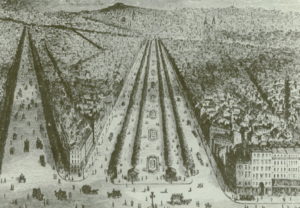
The street plan and distinctive appearance of the centre of Paris today are largely the result of Haussmann’s ruthless reshaping of the city.
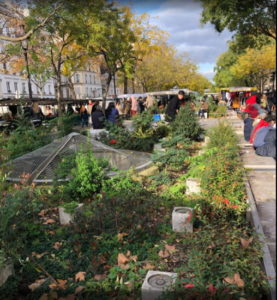
The middle of Bvd Richard-Lenoir is planted with trees and flower gardens, which actually covers over the Canal de St Martin that flows beneath. Out of a couple of the flower beds there are light shafts that allow light and air to ventilate the canal’s towpath.
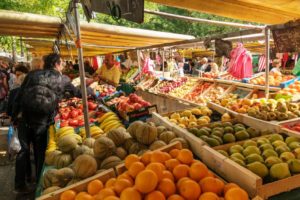
Part of the 11th arrondissement up to its northern-most area, Popincourt, was undergoing a major change at this time with the rise of the textile industry. Two businessmen who hailed from Normandy, François Richard and Joseph Lenoir-Dufresne, opened Paris’s first cotton mill in an abandoned convent in the rue de Charonne. Encouraged by Napoleon, their enterprise prospered, and more mills were set up in Picardy and Normandy. Lenoir-Defresne died aged only 37 in 1806, and it seems that he was so beloved by his employees that their sobs and cries drowned out the priest’s address at his funeral. It was in response to his deathbed request that his partner François Richard adopted his name, being known henceforth as Richard-Lenoir.
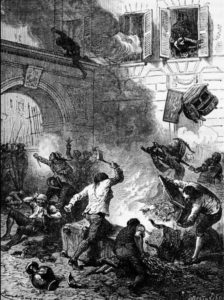
Richard-Lenoir had been imprisoned for debt in 1789 and escaped during the anti-Réveillon riots that year. These riots centred in the St Antoine district of Paris where a factory, owned by Jean-Baptiste Réveillon, produced luxury wallpaper, employed over 300 people. Protests began after rumours spread that Réveillon had made a speech stating that workers, many of whom were highly skilled, were to be paid lower wages so that he could offer his customers lower prices. At the time, there were severe food shortages, high unemployment, and low wages after a difficult winter in 1789. However, Réveillon was known for his benevolence towards the poor, and he had actually stated that bread prices should be brought down to a level that people could afford, but his comments were misinterpreted as wage restrictions.
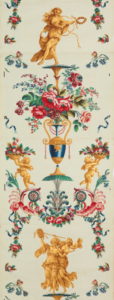
A series of protest marches ensued, and though the first 3 were resolved peacefully, confrontations between troops and participants in the 4th demonstration led to the outbreak of violence. While the protestors did not manage to destroy the wallpaper factory, which was guarded by a group of around 50 armed troops, a factory owned by the saltpetre manufacturer Henriot was destroyed after he made similar comments. Réveillon’s factory was destroyed the next day as was his house. The riot killed 25 people and many more were wounded. François Richard took advantage of the chaos in the city to escape from debtors’ prison.
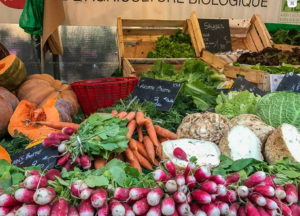
François Richard-Lenoir went on to become one of the richest men in France, though by 1813, competition from imports, a tax on cotton during the Napoleonic Wars, and the country’s deteriorating financial and military situation, all but ruined him.
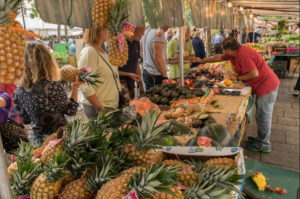
Napoleon Bonaparte at one time had grandiose plans for the area, initially intending to link the Place de la Bastille to the Louvre by way of a ‘rue Impériale’, but like a number of his other plans for the city, it was judged too costly and came to nothing. It was not until Baron Haussmann undertook his massive transformation of Paris under the Second Empire that the Place de la Bastille and its neighbourhood developed into something like its present form. One of his aims was to clear out the old neighbourhoods of the working and “dangerous” classes that inhabited the Faubourg Saint-Antoine, which included the factories in and around the rue Charonne, in an attempt to diffuse the possibility of further uprisings.
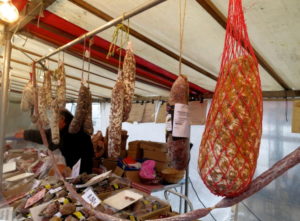
An interesting little aside to the story of the boulevard: Georges Simenon’s famous detective, Jules Maigret, is portrayed as living at 132 Boulevard Richard-Lenoir.
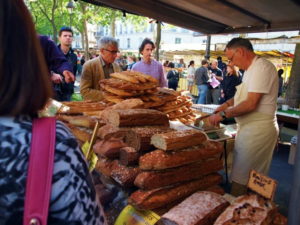
The Marché Bastille-Richard Lenoir is a “marché volantes”, meaning that it’s a roving market, set up on particular days of the week for just a few hours. There are four rows of covered stalls spread along Bvd. Richard Lenoir from the Place de la Bastille end for several long blocks towards Ave. de la République every Thursday and Sunday morning from 7.00am to 2.30pm. It’s easy to understand why this is regarded as the biggest outdoor market in Paris. The selection of produce is enormous, and the quality is the very best of the season. There are well over 100 stall-holders, many are the growers themselves, and many of these are certified organic.
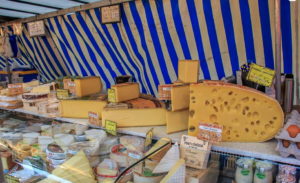
Local cheeses tower over Moroccan pastries, huge piles of freshly baked breads of every description, great tubs of olives, free range poultry, saucisses, cured meats, and impressive displays of excellent seafood. A particularly popular stand sells a variety of oysters shucked to order, accompanied by wedges of lemon and glasses of chilled white wine.
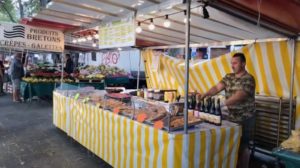
There’s a Breton vendor about halfway down the market who sells galettes freshly made to order as well as specialty Breton pastries. I’ve stocked up on dried fruits such as dates and figs, nuts, herbs and spices, and there’s also lentils, different varieties of rice and couscous and fresh pasta.

We always make a beeline for one of our favourite vendors, La Petite Périgourdine, from the Perigord region. They sell an extensive range of terrines, pâtés and rillettes from that region, and notably highly regarded foie gras from Hélène Mudry, who was awarded the Medaille d’Or at the Concours National back in 2011. We always stock up on numerous tins of many of the goodies on offer to bring home with us.
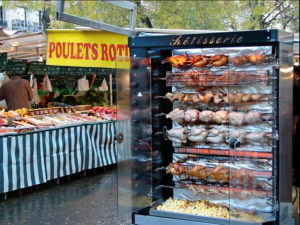
If you’re after something to take away for dinner, there are a couple of stalls selling poulets rotis, with roasting chickens turning on rotisseries, their fat and juices dripping down onto a tray full of potatoes roasting away. With a constant turnover, it’s all guaranteed fresh. There’s certainly nothing more delicious than this!
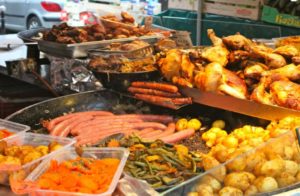
Other tempting hot foods available include Lebanese, Indian, Italian, huge pans of freshly cooked paella, French staples such as crêpes and Boeuf Bourguignon, as well as fresh seafood of every description, perfect for a takeaway lunch if the weather is good, or for dinner.
After choosing the perfect pieces of cheese and super-fresh salad greens, the only thing to add to your purchases is a large bunch of beautiful, fresh flowers, and there are always so many to choose from, even in winter.
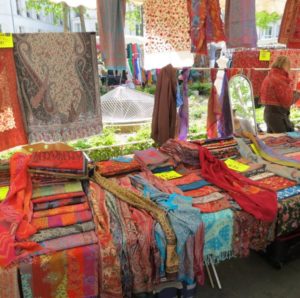
The market not only has a dazzling array of fresh produce, but also a number of stalls selling non-food items. You’ll see a selection of small kitchen gadgets—some of which you may puzzle over their function—and other must-haves. I’ve picked up a couple of light-weight fine linen long scarves, perfect for summer evenings, and agonised over some super-cheap, irresistibly pretty little silk squares, ideal for the neck of a sweater, and refreshed my supply of white gym socks. I’ve been tempted by cute-as-can-be linen cushion covers featuring Toulouse Lautrec theatre posters, and asked myself how I can justify buying more beautiful French jacquard tea-towels that cost a fortune outside France. There are goodies here you didn’t know you wanted until you saw them here, and if you’re after some small gifts to take home, this is a great place to explore.
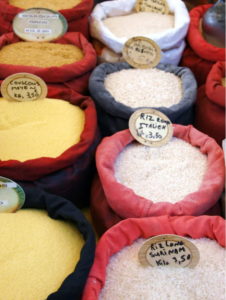
If you want to feel the pulse of this city, the Marche Bastille-Richard-Lenoir is bustling with activity. A guaranteed culinary adventure, and so much more.



Oh Cheryl,
This is fantastic, my mouth is watering!
I love your pieces and really envy your knowledge and experiences of France that your write about so well and often re-read them.
Thank you so much,
Diane Hogan
Hi Diane,
Yes, this market is terrific! Not only the range and quality of the produce, but also the atmosphere. Just strolling along taking it all in is a treat–although I defy anyone to come away empty-handed! Put it on your Must Do list for your next visit. Lovely to hear that you enjoy the stories! Best regards, Cheryl
New gym socks!
Hi Nadine,
When we hit Paris in a few days, this market is on our list, and as you’ve already guessed, a pack of gym socks is on the shopping list–along with a few little tins of fois gras. Talk about one extreme to the other, price-wise! Cheers, Cheryl